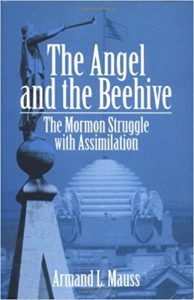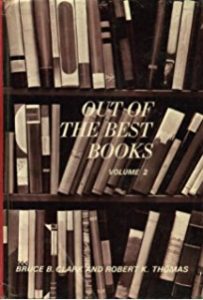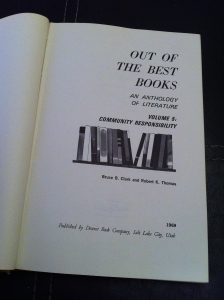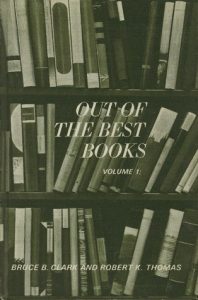The following essay is excerpted from my 2016 BYU English MA thesis titled “Out of the Best Books: Mormon Assimilation and Exceptionalism Through Secular Reading.” This thesis seeks to explore the relationship between Mormon assimilation, exceptionalism, and their endeavors in secular reading by analyzing Out of the Best Books (OOBB), a 1964–71 five-volume reading guide and reading program on secular reading established by the Mormon Church for its women’s organization, the Relief Society. The thesis can be read in its entirety here.
Out of the Best Books:
Mormon Assimilation and Exceptionalism Through Secular Reading
Mormons have long been considered a peculiar people by those outside the faith tradition. According to many scholars of Mormon history and sociology, part of what renders them a distinctive cultural group are the unique tensions or paradoxes that permeate their doctrines and practices. For instance, in People of Paradox, literature and religious studies scholar Terryl L. Givens notes that Mormons paradoxically celebrate both rigid hierarchical structures and individual agency and also emphasize the possibility of both epistemological certainty and eternal learning, creating a mix of “intellectual certitude and intellectual instability” (xv).
Yet one of the paradoxes that scholars have deemed most formative and prevalent is what Givens refers to as “exile and integration” (xv), or Mormons’ perpetual desire to  assimilate comfortably into mainstream American society while also retaining a sense of cultural distinctiveness and separateness from the world around them. Many have commented on this specific cultural tension, but sociologist Armand Mauss’s The Angel and the Beehive offers the most comprehensive and oft-cited model of Mormon separation and assimilation. Mauss notes that Mormons experience ever-present pulls toward both the angel (symbolic of the impulse to separate by clinging to uniquely Mormon doctrine and practice) and the beehive (representing the impulse to integrate with mainstream American society). Yet he and those scholars who affirm his model suggest that, throughout their history, Mormons have primarily oscillated between periods of cultural separation and assimilation in a pendulum fashion, marked by isolation in early Mormon history, Americanization from 1890 to WWII, and cultural retrenchment beginning in the 1960s, with a renewed emphasis on Mormon particularity.
assimilate comfortably into mainstream American society while also retaining a sense of cultural distinctiveness and separateness from the world around them. Many have commented on this specific cultural tension, but sociologist Armand Mauss’s The Angel and the Beehive offers the most comprehensive and oft-cited model of Mormon separation and assimilation. Mauss notes that Mormons experience ever-present pulls toward both the angel (symbolic of the impulse to separate by clinging to uniquely Mormon doctrine and practice) and the beehive (representing the impulse to integrate with mainstream American society). Yet he and those scholars who affirm his model suggest that, throughout their history, Mormons have primarily oscillated between periods of cultural separation and assimilation in a pendulum fashion, marked by isolation in early Mormon history, Americanization from 1890 to WWII, and cultural retrenchment beginning in the 1960s, with a renewed emphasis on Mormon particularity.
Mormons’ struggle to work out their unique identity and relationship to surrounding society is reflected in many aspects of Mormon culture, yet it can be observed especially in Mormon literature, that is, in texts by Mormon authors. Mormon Church leaders have often urged Mormon writers to create a literary tradition that is both distinctly Mormon yet still worthy of acclaim by non-Mormon readers. For instance, in an 1888 address, Mormon bishop (and future apostle) Orson F. Whitney asserted that from among Mormon youth should rise up “Miltons and Shakespeares of our own,” or talented artists who might meet the standards of popular critics. Yet Whitney also insisted that “above all things [these writers] must be original,” arguing that because “our mission is diverse from others, our literature must also be.” Thus, Whitney urged Mormon writers to self-consciously navigate assimilation and separation—writing in a vein the world might praise but also representing Mormon peculiarity in a way that reinforced their separateness.
At the same time, church leaders have also repeatedly admonished Mormons to immerse themselves in literature by non-Mormon authors (what I will call secular literature) from Joseph Smith’s earliest discourses to those from contemporary leaders. Smith first directed early Saints’ attention to secular literature, recording in an 1833 revelation (now canonized in Section 88 of the Doctrine and Covenants) that the Saints were to study and “seek learning” “out of the best books.” Moreover, Smith confirmed that the “best books” should come, at least in part, from outside of Mormonism by recommending in that same passage that Mormons explore “things both in heaven and in the earth, and under the earth; things which have been, things which are, things which must shortly come to pass; things which are at home, things which are abroad; the wars and the perplexities of the nations, and the judgments which are on the land; and a knowledge also of countries and of kingdoms.” Furthermore, admonitions for Mormons to immerse themselves in secular literature can also be found in various articles published over the years in the church’s official magazines. Mormons’ sustained involvement with secular literature suggests that exploring their secular reading habits could also reveal valuable insight into the way they define their identity.
Out of the Best Books
 A comprehensive survey of Mormons’ secular reading, though instructive, would necessitate a book-length project; however, Out of the Best Books (OOBB), a 1964–71 five-volume reading guide and reading program established by the Mormon Church for its women’s organization, the Relief Society, offers a useful starting point. In order to help immerse Relief Society women and their families in literature, editors Bruce B. Clark and Robert K. Thomas curated this collection of classic texts by primarily non-Mormon authors and also provided specific direction on how their Mormon readers might interpret and discuss these selections, creating what Clark himself considered the first official Mormon anthology of classic literature.
A comprehensive survey of Mormons’ secular reading, though instructive, would necessitate a book-length project; however, Out of the Best Books (OOBB), a 1964–71 five-volume reading guide and reading program established by the Mormon Church for its women’s organization, the Relief Society, offers a useful starting point. In order to help immerse Relief Society women and their families in literature, editors Bruce B. Clark and Robert K. Thomas curated this collection of classic texts by primarily non-Mormon authors and also provided specific direction on how their Mormon readers might interpret and discuss these selections, creating what Clark himself considered the first official Mormon anthology of classic literature.
Examining the approaches to secular literature in the OOBB program indicates one way that the Mormon institutional structure suggested church members could navigate the competing pulls to separate and assimilate by making efforts that fulfill both aspirations simultaneously, rather than moving exclusively in one direction. In the case of this program, participants attempted this by embracing mainstream interpretive methods and secular texts while approaching them from a privileged perspective informed by their distinct worldview. In so doing, these Mormon readers sought to assimilate by immersing themselves in popular reading culture while also retaining separateness through their particular interpretations.
Yet Clark and Thomas’s efforts to help readers achieve both objectives did not amount to an entirely seamless navigation of this paradox. On the one hand, the editors did present an interpretive lens that professed participants could discern unique Mormon truths in individual texts and detect a narrative of universal truth compatible with Mormon principles present throughout secular literature. They claimed that these conclusions would allow readers to feel confident in the privileged insights their Mormonism provided while still seeking and embracing truths outside their faith tradition. On the other hand, the editors’ attempts to incorporate texts that might challenge Mormon notions of morality, as well as their efforts to introduce world literature and fully address their female audience, raised many additional tensions. These tensions included how Mormons might determine what they should welcome and what they should avoid when exploring “truth” beyond Mormonism and also how they might acknowledge diversity of opinion and experience when focused on a singular narrative of universal truth. Thus, OOBB demonstrates the many nuanced obstacles Mormons faced in one particular effort to navigate this cultural paradox, exposing the complexity of simultaneously navigating assimilation and separation.
OOBB’s Beginnings
As Clark describes in his unpublished autobiography, OOBB was first conceived in the spring or early summer of 1962 when Alice Wilkinson, wife of then Brigham Young University (BYU) President Ernest Wilkinson and member of the Relief Society’s administrative General Board, called him on the phone to ask if Clark, as a BYU English professor, might have any suggestions for improving the Relief Society’s current literature program. Clark responded by suggesting that one might make the lessons more interesting and meaningful for class members by focusing “on the literature itself rather than on the background history or the lives of authors” (as had heretofore been the case) and by ensuring “that the selections studied should be short enough that copies could be made for women to have and to read, preferably in advance of the class so they could participate in better discussions” (Clark Autobiography 1:473). Whereas the current program involved the women discussing a particular work in general terms but never actually reading it, Clark proposed that women be more directly immersed in the texts themselves.
Accordingly, Wilkinson invited Clark to take responsibility for compiling an anthology of literature (which, with the enthusiastic reception of the first volume, ultimately turned into five) that Relief Society women could read and discuss in their monthly literature meetings. Overwhelmed yet eager to embark on what he later called “the most influential and most widely studied and discussed writing I ever did” (Clark Autobiography 1:473), Clark enlisted the help of fellow BYU literature professor, Robert Thomas. Over the course of the next seven years, Clark and Thomas compiled five anthologies and sold each through the church’s publishing house, Deseret Book, for a nominal $2.95 so that each Relief Society woman and her family could purchase and retain copies for their home libraries. Although Clark was never told an exact figure, he estimated that over 100,000 copies of each volume were sold to tens of thousands of Relief Society women and their families both nationally and internationally (Clark Autobiography 1:489).
While OOBB’s inception was initiated by church leaders and the program’s title alludes to Joseph Smith’s scriptural injunction to explore literature, Clark and Thomas clearly drew heavily from the secular Great Books tradition when designing the OOBB program. Like the twentieth-century proponents of Great Books courses, lists, and anthologies, Clark and Thomas championed the universal applicability of “classic” Western texts for all readers, presented reading as a means of individual and social betterment, and advocated a kind of literary elitism that insisted the “best” literature could be clearly defined in a discrete canon. The editors even included in their volumes several essays on reading by Mortimer Adler, one of the central Great Books advocates and a co-founder of Britannica’s Great Books of the Western World.
Yet OOBB’s unique focus on a Mormon female audience set the program apart. Although the editors’ success at directing the entirety of their curriculum toward female readers is limited, both the presentation and distribution of the OOBB volumes as well as their description of the program suggest women to be their intended readers. Clark and Thomas designed the program for Relief Society women specifically and announced their intended focus in the first Relief Society Magazine article introducing the program, stating that each OOBB section would be “centered around a womanly attribute.” Moreover, the editors also incorporated several female authors throughout their volumes, presumably to better consider the unique perspectives of women.
 Clark and Thomas also sought to tailor their program to meet the needs and values of their particularly religious audience. In the introduction to the first volume, Clark explained that “a basic purpose in writing this book has been to discuss works of literature that support principles of the Gospel” and thus “enrich and strengthen our spiritual lives by reading the high-quality literature of the world” (1:ix). The editors expressed a desire to include longer selections, yet space restricted them to poems, essays, and short stories centered on these themes—primarily heavily-canonized British and American Romantic and Victorian literature by male authors. However, the editors did slightly expand the canon in ways other contemporary anthologies and reading programs did not: approximately twenty percent of the texts were written by female authors and five percent by non-Western authors.
Clark and Thomas also sought to tailor their program to meet the needs and values of their particularly religious audience. In the introduction to the first volume, Clark explained that “a basic purpose in writing this book has been to discuss works of literature that support principles of the Gospel” and thus “enrich and strengthen our spiritual lives by reading the high-quality literature of the world” (1:ix). The editors expressed a desire to include longer selections, yet space restricted them to poems, essays, and short stories centered on these themes—primarily heavily-canonized British and American Romantic and Victorian literature by male authors. However, the editors did slightly expand the canon in ways other contemporary anthologies and reading programs did not: approximately twenty percent of the texts were written by female authors and five percent by non-Western authors.
Yet like other Great Books proponents, Clark and Thomas guided their readers’ interpretations toward their intended moral focus. They prefaced each chapter with an explanatory note, concluded nearly every selection with at least a paragraph of explication, and provided an entire chapter on how to become a critical reader generally and a critical Mormon reader more specifically. While they were quick to state that they “claim no infallibility in literary interpretation” and “encourage readers to explore meanings in the poems and stories that [the editors] may have missed or even misrepresented” (1:xi), Clark and Thomas still exhibited clear intentions to direct their readers in finding uniquely Mormon insight in secular texts, thus helping them both assimilate to popular literary culture and remain peculiar at once.
Part 2 of this essay can be read here.
Lauren grew up in Seattle, Washington, and earned a master’s degree in American literature at BYU last year. She is currently a writer and content manger for DeseretNews.com in Salt Lake City, but continues to have an interest in contemporary American literature and Mormon literature.


Interesting! I remember these volumes on my mother’s bookshelf. You say there already was a literature program before these books, but it just focused on the lives of the authors. When did that start? Also, were the discussions of the OOBB readings done on Sunday, or in the weekday Relief Society meetings they used to have before the 1980 consolidation? Also, did the books include Mormon authors?
Good questions. I don’t know exactly when Relief Society lessons began including discussions of literature, but from my memory, years prior to the OOBB program (perhaps even decades), the Relief Society Magazine was already providing curriculum for a monthly literature lesson, usually focused on one particular author like Wordsworth or Shakespeare. These would often focus on discussions of the author’s life rather than any close reading of their work. And yes, the OOBB discussions were held on weekday evenings, I believe during the fourth week of every month. Texts by non-Mormon authors make up about 90 percent of the volumes, but the editors did include selections from several Mormon authors, including several poems by Carol Lynn Pearson and Eliza R. Snow. I do have a list of all the authors in the volumes on page 53 of my thesis if you are interested.
Jason Kerr at By Common Consent wrote a post about Relief Society President Clarissa Smith Williams from the 1920s. He said, “She believed that women could learn out of the best books, so the 1928 Relief Society curriculum included a literature course focused on six modern plays, like Ibsen’s A Doll’s House and Shaw’s The Devil’s Disciple.” Can you imagine studying “A Doll’s House” in Relief Society? Michael Austin, in the comments to the post, said that there was a similar program in the MIA. “I recently discovered that the annual reading list for the MIA curriculum began in 1907 with Samuel Johnson’s Rasselas, which was serialized in the Improvement Era so that everyone could read it during the year. From 1908 to 1920, the annual curriculum included Silas Marner, The Last of the Mohicans, A Tale of Two Cities, Little Women, and Lamb Tales from Shakespeare.” https://bycommonconsent.com/2015/03/08/clarissa-smith-williams/
That’s very interesting. I can’t imagine reading “A Doll’s House” in Relief Society!
Also, the two male editors are the only figures that appear.This was a little bit before full correlation (which was in 1970?) Do you know much the females of the Relief Society board were behind deciding to go forward with this program?
From what I can tell, the Relief Society had a fair amount of oversight. The Correlation Reading Committee, which approved all curriculum for OOBB, included several Relief Society General Board members. At one point, Marianne Sharp, a committee member and first counselor in the Relief Society General Presidency, rejected an entire chapter of the fourth volume “because the examples used were in the lives of men not women and therefore not applicable to women.” And Relief Society General Board member Alice Wilkinson also urged Clark to feature more women. (I included some of their correspondence on pages 30 and 40 of my thesis.) That being said, beyond participating in the final approval of the volumes, I don’t believe the Relief Society was very involved in selecting texts or writing explicative passages. They seemed to put a fair amount of trust in the editors’ expertise as literature professors.
.
I have a question about your phrasing in the intro: “established by the Mormon Church for its women’s organization, the Relief Society.”
I’m not an expert and not pretending to be, but wasn’t the Relief Society autonomous enough at this point that it would be more accurate to say the reading program was established by the Relief Society for the Relief Society?
.
Oh, wait. I just saw your last comment.
I think my question still stands though if it was the RS that started and led the project—?